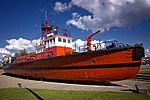Slater Museum of Natural History
Museums in Tacoma, WashingtonNatural history museums in Washington (state)University museums in Washington (state)University of Puget SoundWashington (state) building and structure stubs ... and 1 more
Western United States museum stubs
The Slater Museum of Natural History is a natural history museum in Tacoma, Washington. The museum is located on the campus of University of Puget Sound at 1500 N. Warner St. Tacoma, WA 98416. The museum's collection has 29,987 mammals, 26,340 birds, 8,237 amphibians and reptiles, 12,500 insects and 13,000 plants. The collection grows at a rate of one to two percent every year. It was founded by James R. Slater.The museum is host to the world’s second largest bird wing collection. The images are available to the public through the University of Puget Sound’s Wing & Tail Image Collection.
Excerpt from the Wikipedia article Slater Museum of Natural History (License: CC BY-SA 3.0, Authors).Slater Museum of Natural History
North Warner Street, Tacoma North End
Geographical coordinates (GPS) Address Website Nearby Places Show on map
Geographical coordinates (GPS)
| Latitude | Longitude |
|---|---|
| N 47.2636535983 ° | E -122.48279435102 ° |
Address
University of Puget Sound
North Warner Street 1500
98416 Tacoma, North End
Washington, United States
Open on Google Maps





